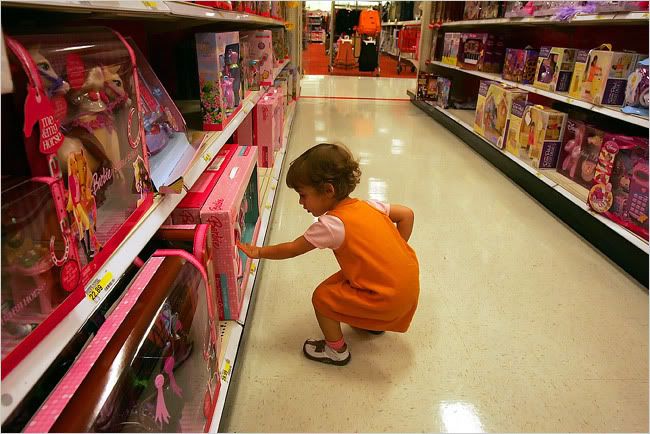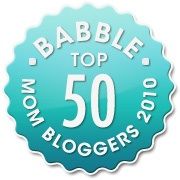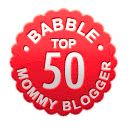Are Our Kids Safe From Lead? The Toy Industry Thinks So.
 Ever since I first posted about lead in toys, and then worked with Kristen to set up a comprehensive Safer Toy Guide on Cool Mom Picks, the issue has established permanent lodging in my brain. A year ago I wouldn't have thought twice about bringing home those cheap souvenir maracas from Mexico. But now? I'm compelled to wonder what exactly they're made with and how exactly I'd feel about them ending up in Sage's mouth.
Ever since I first posted about lead in toys, and then worked with Kristen to set up a comprehensive Safer Toy Guide on Cool Mom Picks, the issue has established permanent lodging in my brain. A year ago I wouldn't have thought twice about bringing home those cheap souvenir maracas from Mexico. But now? I'm compelled to wonder what exactly they're made with and how exactly I'd feel about them ending up in Sage's mouth.In some ways I feel myself slipping in vigilance, becoming more open to mass-produced playthings than I was during the recall-a-day insanity of November and December. But the truth is, the issue isn't over. It's just less appealing to the Today Show producers.
Then last week Melissa informs me that Bush's yesterday proposed level funding for the Consumer Products Safety Comission in his 2009 budget. Yesterday I see this article in the NY Times about high lead levels in the plastic of baby products. And last month I get a press release (one of the rare relevant ones) about my all-time favorite shop, Wal-Mart (snort) continuing to sell lead-tainted bibs since they weren't "officially recalled" outside of Illinois.
Maybe Wal-Mart can change their slogan to Everyday Low Standards? Catchy!
And so this seems like as good a time as any to remind everyone that we should keep the pressure on. It's also a good time to (finally - sorry!) post the answers that Joan Lawrence, the VP of Safety for the Toy Industry Association, gave to the wonderfully insightful questions that readers asked here of her back in December.
Thanks to Ms. Lawrence for her willingness to face the moms. And big thanks to Rachelle Lacroix of Fleishman-Hilliard who's been amazing at facilitating this all.
I'd rather not editorialize except to say that an emailed Q&A format doesn't inherently have the immediacy and honesty that an actual interview situation can provide. But in any case, the following are the answers verbatim.
---
Q:
A: Most toys, especially those sold at major retailers as well as specialty toy stores, are tested against our US standards in their normal course of manufacture. However, when the lead-in-paint recall issue arose, major retailers and toy brands began massively re-testing products from store shelves and warehouses, to ensure the safety of the products and reassure consumers. A conservative estimate is that over 20,000 different types of toys have been retested in this effort by toy manufacturers and retailers.
Q: Anecdotally, I have heard several stories of recalled toys remaining on shelves at a major retailer, only to be declined at register. This means toys with harmful lead content are still in reach of children. Are there penalties for retailers who do not immediately remove recalled toys? - Me
When a recall happens, retailers must immediately remove product from store shelves and post recall notices. As you note, some retailers have an added level of assurance with software systems that do not allow a toy to be rung up at the register if it has been recalled. This is an important safeguard that prevents the sale of recalled toys, in the event that a toy was not in its proper shelf-space when store employees were clearing the recalled product. This safeguard prevents the recalled product from leaving the store. If you have concerns, notify the store manager immediately.
Penalties can be imposed against retailers that continue to sell product that violate U.S. laws. More importantly, reputable retailers are highly motivated to remove recalled toys because they value and rely on the trust of their customers, and need to protect their good name as well. Just another reason to shop with retailers you know.
(Mom101: I guess Wal-Mart needs some more motivation then. Ack, sorry. Can't help just a wee bit of editorializing.)
Q: While there are there is testing of random samplings of cosmetics, food, and drugs, why don't toys get the same treatment, and do you believe they should going forward? - Angela
A: Normally, toys are sampled and tested at the point of manufacture -- and to a lesser extent, once product has reached store shelves. However, testing “at manufacture” (at design, then again before, during and after production) is the most efficient way to ensure compliance so this has been the emphasis of recent efforts to strengthen the toy safety testing system. In this way, potential issues can be addressed early on before the toy gets to the marketplace.
New protocols are being developed for the timing, frequency and sampling of testing to ensure consistent compliance with standards, in light of recent recalls for lead in paint. In this effort, the toy industry is working with the American National Standards Institute (ANSI is an independent, not-for-profit standards development organization) to implement this industry-wide, mandatory program.
A: There are many types and brands of XRF analyzers. Although they can be a useful screening tool, these are very expensive commercial products that require proper training to use and understanding of the toy safety regulations. There is the potential for variability in results depending on the materials tested and the training of the user (and we have seen examples of these misuses in the media lately, providing erroneous info to consumers). Instead, manufacturers use a variety of testing methods and protocols (including federally mandated test methods) to insure that paints are lead-free, and testing at the earliest possible point in the manufacturing process allows for issues to be detected and corrected early on. (That’s why as an industry we are developing protocols to include testing before, during and after production – before products are shipped – as that is the best way to prevent issues.) Look for future news on the toy industry’s efforts to strengthen the toy safety system at www.toyassociation.org and www.toyinfo.org
Q: Many have called for the resignation of CPSC president Nancy Nord for among other things, her opposition to a bill that would increase CPSC's budget and staff, accredit testing labs, and make regulations stricter. What's the TIA's perspective on this bill? And how does the TIA reconcile your plans with the apparently negative attitude of the CPSC towards regulation? -Julie and Candace
A: The Toy Industry Association (TIA) has gone on record in support of increased funding and staff for the U.S. Consumer Product Safety Commission (CPSC) to perform its important role on behalf of consumers.. While CPSC is an agency of dedicated, highly knowledgeable professionals, it does need increased resources to cover the 15,000 different types of products under its purview. In addition, TIA has specifically called on Congress to pass legislation for mandatory testing of toy safety, by accredited labs, and this will be key to strengthening the toy safety assurance system. TIA’s initiative with American National Standards Institute (ANSI, see #3 above) is intended to directly complement and enhance such legislation. The CPSC as well as legislators, have commended the industry on these ongoing efforts and the industry’s commitment to strengthen the toy safety system.
Q:
A: Recognizing that it has been nearly 30 years since the lead in paint regulation was implemented, TIA and its members recognize that the lead paint standards need to be reexamined. We support the concept of stricter limits for lead, consistent with scientifically based hazard requirements, in accessible components of children’s products. In some cases, however, electronic components for functional reasons might need to be excluded since children would not be exposed to these inaccessible components. The toy industry also supports changes in the lead requirements for toys at the federal level, rather than having a patchwork of inconsistent laws in each state.
Q: The initiative that TIA has developed "to make sure none of this happens again," is it voluntary or law? What happens if a company chooses not to participate in it? -David
A: That’s an important question. In addition to our TIA initiative in conjunction with ANSI, TIA and its members have called upon Congress to make toy testing mandatory going forward. This is key to our initiative as the improvements to the system need to be consistent and industry-wide. Our initiative and federal legislation are meant to work hand-in-hand.
Q: How can parents participate in the standards-setting process? - Anon
A: US toy safety standards are developed under the standards body, ASTM International and include participation by a range of stakeholders including industry, retail, pediatricians and other medical experts, government, and consumer representatives. Parents and other consumers can participate directly, or have their concerns raised through various consumer organizations whose mission is to represent consumer interests. (Contact astm.org for more information.)
Q:
So why would phthalates be banned in Europe? Even the European Commission’s own scientific experts, the European Chemicals Bureau, after a multi-year study of DINP, found no reason to ban the substance in children’s products. Oddly enough, the European Commission ignored there own experts’ recommendation.
So why not just switch materials anyway? US government health scientists specifically cautioned against moving away from a safe substance like DINP to lesser known, less tested alternates that could present acute risks. The fact is that none of the potential substitutes for phthalates have the safe track record that DINP, does. With nearly 50 years of safe use, and extensive study specifically demonstrating its safety in toys, DINP is a good choice for children’s products.
For more information, see the Industry Statements on this issue and reference a copy of the study at toyassociation.org.
Q: What are the measures in place to regulate other toxic chemicals in toys including cadmium, chlorine, pvc, arsenic and mercury? - Jule
A: The US Consumer Product Safety Commission can and does regulate the use of hazardous heavy metals in children’s products (such as cadmium, arsenic, mercury and others) under the Federal Hazardous Substances Act (FHSA). These heavy metals are also limited in paint and similar surface coatings under the US toy safety standards of ASTM International to reduce children’s exposure to these naturally occurring substances. These substances are never intentionally added to a toy and the federal requirements and safety standards limit amounts of these naturally occurring substances, that may be picked up in the environment, to trace levels..
In contrast, PVC is not a heavy metal and is widely used in lots of products from life-saving medical equipment to cars, clothing, shoes and accessories, and children’s products. There is a lot of misunderstanding about PVC. Under the FHSA, if PVC products contained hazardous heavy metals they would be restricted from sale and banned by the CPSC. When CPSC finds a potential hazard, the agency acts through recall and other means. (See Q#9 above regarding phthalates, which are the softeners added to PVC to make it soft, pliable and durable, and eliminate the chance of breakage, sharp edges and small parts.)
(Mom101: But evidently the CPSC does not always act if a product contains a hazardous heavy metal. Like lead. See also: The Illinois-only bib recall. Okay, I'll shut up now.)
Q: What happens to the recalled toys? How do we dispose of recalled toys safely? And is there any way to regulate toys that are resold by either unscrupulous or uninformed individuals through venues like eBay? -
A: Consumers should return recalled toys to the manufacturer, who is responsible for proper disposal. (Companies involved in lead-in-paint recalls are working with environmental experts to conduct appropriate disposal and to avoid environmental contamination.)
As for regulation of the sale of recalled products online (or through other second hand markets), this presents a challenge. It is difficult to control the resale of toys via eBay or even garage sales. eBay has been working with the US Consumer Product Safety Commission for several years to post notices to buyers to prompt them to check recalled product lists before buying. In addition, eBay does attempt to monitor its marketplace for recalled toys, but given the number of products sold there at any given moment, buyers still need to beware. (Second hand stores like those run by national charity organizations are also trying to screen products.) Any retailer or re-seller of products are subject to CPSC jurisdiction. CPSC has the authority to stop sale of dangerous recalled products wherever sold in the U.S.
We always recommend that when buying toys on eBay or in second hand outlets, check the recalled products list first. If you are aware of a recalled toy that is being placed on sale, you should bring it to the attention of the individual seller and/or manager of the online marketplace
Q: Obviously consumer confidence in Chinese-made toys is way down. Why do we believe that a country with an atrocious human rights record cares about making toys safe for our children? And why do we continue to grant them the best possible access to our market while they keep their market relatively closed to us? - Candace
A: Countries don't make toys; companies do. And products sold here in the US, regardless of where they are produced, must comply with our US standards. Companies planning to sell in our US market need to be responsible for ensuring the safety and quality of their products. That’s why the US toy industry is focusing on improving its toy safety assurance process, including making sure that its manufacturing suppliers (be they in China or anywhere) know the US requirements and abide by them.
At the same time, China has recognized that consumer confidence has been shaken. They have demonstrated their concern about the lead paint that infiltrated some of the supply system, and they have increased their on-site inspections at the factories as well as at the ports. In many instances, they have embargoed goods until appropriate proof of testing could be provided and have closed factories that could not demonstrate proper compliance. In these ways, China has demonstrated its commitment to address its current product safety issue. We, as an industry, will continue to encourage this support and increased vigilance by China’s government.
For info on the toy industry’s efforts to ensure safe and fair working conditions in toy factories, see www.icti-care.org
----
Thoughts?

















22 Comments:
All of this makes me long for the old days when you could go to a small toy shop where the toys were lovingly crafted by hand. Of course then you might be dealing with splinters in a wooden train. ;)
I'm sorry but I just got an email about how cloned meat is going to be for sale but will not be identified to the consumer. I'm starting to really believe that most industries just suck.
And while many things about China need to change, I do agree that it is up to the U.S. companies that outsource there to do a better job of quality control.
Thanks for putting this all together.
I'm suffering from freak-out weariness, trying to decipher which are the most important areas to be concerned. I think I'm tossing my Avent bottles and getting new BPA-free ones, for instance.
What I still don't really understand is how the lead-painted toys got into the marketplace if there are such strenuous tests in place already. If every toy is tested during the manufacturing process, how did so many slip through the cracks and need to be recalled? It shows a breakdown in the system that no one wants to take responsibility for.
Did Joan Lawrence think she was easing our minds and giving us confidence in buying toys again? Because I'm perhaps MORE freaked out and wondering if my kids will be safe with origami toys from hear on out (ohh! Paper cut!). Cheryl's point was right on: if everything is so very well tested in the first place, then there is a flaw somewhere in the system and it seems that everyone is too busy passing the buck to figure out where.
Either way, this was very enlightening and thanks so much for putting it together for us.
This issue freaks me out more than pretty much any other (and there are LOTS of others. LOTS.) And there's nothing that anyone can say to make me feel better until there's some kind of iron-clad guarantee that stores WILL NOT SELL TOXIC SHIT for kids. Or pregnant women. Or anyone.
(sputter, sputter, sputter...)
I guess it all comes down to trust. In the answer to my question about random sampling she said they test at the site of manufacture. Who tests? How often? I'm pretty sure it's not US officials, so are they company employees? Chinese gov't officials? Do we trust them?
No, I'm afraid I do not. I'd feel a lot better knowing toys were being randomly sampled by OUR government's employees just like food, drugs and cosmetics are. We don't trust other countries to test our food supplies at the point of manufacture. They're tested here, by our guys. Of course that means we're still "trusting" someone, but at least we know they're getting paid by us with our tax money and hopefully don't have a conflict of interest.
I don't know. Somehow I'm really not feeling any better about it.
wow mom101 you are amazing to get this all together + keep us moving forward on getting the lead out. you get so much done even with a sleep deprivation and 2 cuties!!!
please be my valentine + enter to win a $100 whole foods gift card, where i hope there is no lead in the toys :)
Her response about phthalates is interesting, especially since they released a study two weeks about about phthalates affecting reproductive hormone levels in babies, and some experts recommending that parents keep babies away from anything containing phthalates.
I wish I could say I felt better, but I don't. I can't trust that companies and the Chinese govt. have our best interests in mind instead of their own profits.
Thank you!!!!
This is the first time I have heard about the WalMart bibs. We used those for Princess and still have them at home. She likes to use them with her baby dolls but that's about to come to an end.
I'll be getting rid of them tonight.
Re: that NY Times article, I did hear from Medela, who were not aware of a problem with the lining of their bottle carriers, but are now retesting them for lead. Meanwhile said they will take returns from parents who are concerned.
WOW mom101, thanks for doing this. How many lawyers do you think they needed to write the answers?
rule of thumb - the more words they need to answer your questions, the more full of crap they are.
just make safe stuff. period.
Re: Phthalates and scientists
Some "scientists"also insisted that global warming was not real. It's probable that said scientists were funded by parties who had an interest in keeping things status quo and were under pressure from the Bush Administration to "play down" the threat of global warming, as many have inasmuch admitted.
That said, why on earth should any American consumer believe ANY so-called scientists when they say phthalates are safe, especially when there is an abundance of evidence from OTHER scientists that is contradictory to that claim?
And FWIW, there were a lot of scientist-types who insisted the earth was flat, too.
Thanks for the great work! Tracking this information down is so difficult. There is no way any manufacturing facility would test every toy for lead. I've worked in several manuf.sites and testing is more expensive than the cost to make the product in many cases. They just wouldn't do it. The problem with all of these toxic materials is that they are *cheaper* than all of the alternatives. Until companies see that consumers care enough to fork over extra $$, they won't change. Also, we need to ask ourselves why our government isn't working harder for our children's safety? Who are you voting for in November and locally? Thanks again! Sarah
Unsafe toys, cribs and other items caused at least 657 injuries and six deaths last year.
Thank you for keeping us updated on such an importnat issue. It's so scary that we have to be so worried about everything our kids put in their mouths these days, from toys, to bottles, to food.
I'm proud to belong to the website www.etsy.com where all the products are handmade by excellent crafters, including kids toys and products. It's a safe alternative to the questionable products being shipped in from China.
Tough issue and there are many good point made here. Can I just say YAY! for having teenagers at this point in time. Because no one's putting toys in their mouths. Never have video game addictions looked like a safer alternative.
Are our kids safe from lead? Possibly. What does "safe from lead" mean? If it means a particular likelihood or less of suffering certain lead-related consequences, then the answer can be determined. But if it's about the parents' level of concern about it, then the producers of the Today Show are genuinely helping to "solve" the problem for many people, albeit not for you.
If you think kids aren't safe from lead, what lead you believe that in the first place? Could it be that the Today Show and its ilk were _overselling_ the issue, and are only now returning to the proper journalistically warranted coverage level? How could you tell?
Hmmm. I'm going to have to think about these answers. They weren't bad answers, but I have trouble buying them for many of the same reasons PPs have said, especially what Cheryl and Izzy said. I also want more details, like who is performing the studies, by whom they are funded, in what way are they supporting changes in government standards, etc. etc.
Mom-101, you totally rock for facilitating this and getting our questions answered. Thank you for all your work on this, and on the safer toy guide.
Sarcasta-Mom, great point - etsy is a wonderful source for handmade items, with artists who really do care how their goods are made and where their materials come from. We're proud to feature many etsy artists on Cool Mom Picks.
And Jonathan, I'm truly sorry if I in any way compromised your Wal-Mart stock.
I don't have any Wal-Mart stock (or any stock). I asked my questions for the same reason I assume your other readers ask questions, which is to get answers. No one owes me those answers, but I still thought I'd ask.
It matters. If (making vast simplifications here, but the principle is sound) bad thing "X" kills, say, 9 kids per 100,000 per year, and bad thing "Y" kills 1 kid per 100,000 per year, that doesn't mean you should be using 90% of your child-saving resources to prevent "X" and 10% of them to prevent "Y". You should be using 100% to prevent the greater killer.
Which is X and which is Y? Is it lead? Bad politics? Global warming? Poor nutrition? Preventable diseases? This is one case where diversification (splitting your time among competing worries) is a poor strategy, as it guarantees you will be wasting your time on low payoff remediation while bigger issues go unaddressed. Unless it's all about you feeling good because you're "doing something", which is what I was asking. And Happy Valentines Day!
Thanks Liz. And thanks to Joan and Rachelle too. I realize that they're only the messengers.
Post a Comment
<< Home